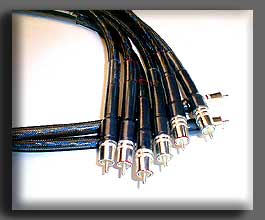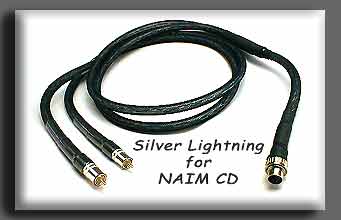 Silver Lightning Interconnect
Silver Lightning Interconnect
 BEAR Labs Cables (v4.04)
BEAR Labs Cables (v4.04)
Silver Lightning
is
arguably one of the finest interconnects ever. What makes
it different than other
'silver'
cables? Aside from a very high build quality,
premium components, custom manufactured
ultra high purity silver wire and Cardas
connectors? It is what I call "natural timbre
and tonal balance."
Almost anyone
can buy solid core silver wire and fashion a home brewed silver
cable. That's not all bad. However, after
you experiment even for a little while
you'll notice that somehow the silver wire
sounds different than copper or even
silver plated copper wire - especially when
used as interconnect. I have found
that when used between a turntable and pre-amp
(very low level signals) that the
effect is even more pronounced. Generally
speaking, silver tends to exhibit "tinkly "
and clean sounding highs, while being a
bit thin and anemic in the lower mid registers
and bass region.
Please click on the picture above for
a close-up of the cables...
Here's a new picture
of Silver Lighting 
If you want this
particular effect in your system - a "tone control" of sorts -
then just about any silver wire is fine.
My philosophy is to avoid creating products
that act as "tone controls." It is impossible
to completely adjust or correct one error with
another. Trying to do this is (what I call)
"complementary colorations." An example
might
be using a "dark" amp with bright speakers,
or dull cables with a bright amp, etc. I feel
that this is a common trap for "high-end"
audiophiles and should be avoided. So, I offer
Silver Lightning as an interconnect that
is virtually free of its own character or
"sonic signature." Now you have the opportunity
to eliminate interconnects
as a source of coloration in your system,
and focus elsewhere.
Silver Lightning
is made from multiple gauge strands of high purity silver wire which is
then
extruded into a jacket of genuine duping
FEP (one of their Teflontm products) resulting
in
approximately 20awg wire. I then braid the
wire, isolate the braided conductors inside a
clear 0.375" PVC sheath, and cover that
with black fiberglass mesh, finally Cardas
SRCA (silver plated) RCA plugs with "Teflontm"
insulation terminate the interconnect.
Electrically, Silver Lightning is also very
low capacitance - on the order of 12-14pf/ft.
The result is a durable, rugged and sonically
wonderful interconnect. One that truly
sets the standard for performance and quality.
Note: A DIN style Silver Lightning
is available for use with tone arms. If there is one
place where Silver Lightning will make a
really huge difference it is between the tone
arm and the phono front end.
About XLR:
yes, I do make XLR
interconnects, although they are
more expensive than the standard Silver
Lightning, since they are essentially TWO Silver
Lightnings, under one "roof". This is because
balanced has two signal paths, while RCA has
only one.
Also, here's a Custom Shop version of Silver
Lightning for NAIM CD players!

Silver Thunder Speaker Cable (pictures soon to materialize here!)
Silver Thunder is
the companion to Silver Lightning. It too is remarkably free of artifacts
and it's own "colorations" or "sonic signature."
Please, for more information, for
pricing and
details send me an email.
Ok, here's some more on Silver Thunder!
(Please be sure to read the section in Design Philosophy on "Complementary Colorations"The number one contributor to the sound of a speaker cable is not the wire, not the insulation,
so that you are up to speed reading here...)
Why this happens is not 100% clear, and many
objectivist researchers are hard pressed to find
these differences to begin with -
or more importantly, correlate the measured differences with
the subjectively heard differences. More
often than not the measured differences are small,
while listeners often report "huge" differences
in the perceived sound. I'm not going to try to
explain this entire paradox, only explain
what I have found and why I think that it's correct.
So, in short, the best speaker cable is NO
speaker cable, just like the best interconnect, is
NO interconnect! In other words, it would
be best to simply put your amp directly on the
speaker terminals - at least in theory!
Turning that idea around, the best speaker cable would
act exactly like a direct connection between
the amp and the speaker.
This dovetails with the idea of complementary
colorations - you don't want any that you can
definitely avoid. Or, the less you change
or alter, the more you get!
How Cable Geometry Works
Some "designers" of
speaker cables have done all sorts of things to the cables to effect a
change
to the signal - many in the name of "improving"
the "interface" or "impedance matching", or other
ideas... This usually takes the form of
some sort of "box" on one or both ends of the cable, or some
sort of unique geometry which adds capacitance
and/or inductance.
As far as I can tell, *any* attempt at these
things generally results in some sort of unpredictable
interaction with either the speaker and/or
the amp. I say "unpredictable" because it may sound
"good" with one set up, but may impart some
dip or boost in another. Again, this falls under the
general heading of "complementary coloration."
I want to avoid that problem if at all possible!
There are a number of cables that use a geometry
that adds considerable capacitance (same as putting
a cap between the plus and minus terminals
of your amp) - some people like them because it then sounds
more "open" and "faster". Well, if you look
at *most* amps with a capacitive load added you'll see
a very real overshoot on the leading edge
of a square wave - this translates to precisely an
increase in HF energy. This is actually
a type of distortion.
The other extreme is a cable whose geometry
adds inductance - these cables generally sound "smoother"
since they slightly roll off the high end,
very slightly in most cases. These cables were very popular a
number of years ago with a certain huge
power amp and ESL combination since they "tamed" the combo's
tendency to sound a bit strident.
BEAR Labs Silver Thunder
The idea behind Silver Thunder is to do the same thing that Silver Lightning does - nothing.
Of course, this is an ideal that is impossible
to achieve in the real world, so the question becomes
"how good is your approximation?" To this
I answer, "pretty darn good!"
There are, of course, some design decisions
that have to be made when any product is developed.
With Silver Thunder, I think that I've held
the price/cost line at the same time as making a
speaker cable that more than meets the design
goals. Namely, being essentially neutral, well
balanced tonally, and free of interactions
with speakers.
Each Silver Thunder set has on the order
of 150 feet of stranded, teflontm (dupont's tm) insulated
Silver Plated Copper wire. I use SPC and
not pure silver, since the SPC in this application gives
outstanding performance at a modest cost.
Pure Silver could be used for this, but the cost to me
for the wire itself would be on par with
the price that I can now sell you the completed Silver
Thunder Cable!!
If you would like a pure Silver version of
Silver Thunder, by all means, please email me, and
I'll be happy to give you the best quote
I can for a set!! Would it be better? I think it might
be just ever so slightly better! This is
the definitive way to go for a system that is virtually
perfected in all other regards. La creme
de la creme!
So, if you are seeking a speaker cable built
without regard to cost at all, then pure Silver is the
way to go. If you are seeking a speaker
cable built without regard to sonic compromise, then
Silver Thunder is the way to go.
Oh, BTW, the finished "look" is similar to
the Silver Lighting Interconnects shown above, and
I use Cardas spades. Other terminations
are available on request (usually).
Jumpers are available as well, and I prefer
these over bi-wiring arrangments - email for details,
and the theory behind this...
"teflon" is a registerd trademark of DuPont - the wire used in Silver Lightning is made with DuPont polymers.